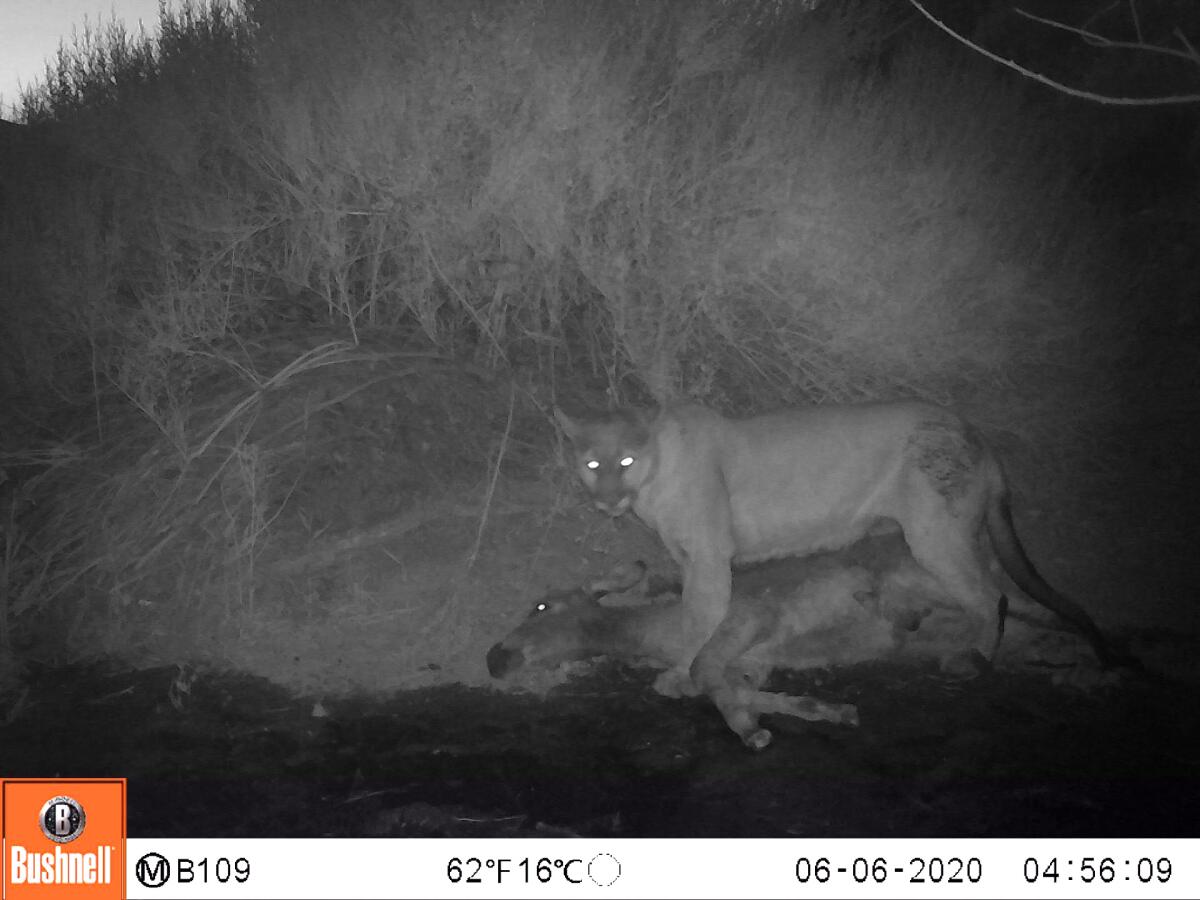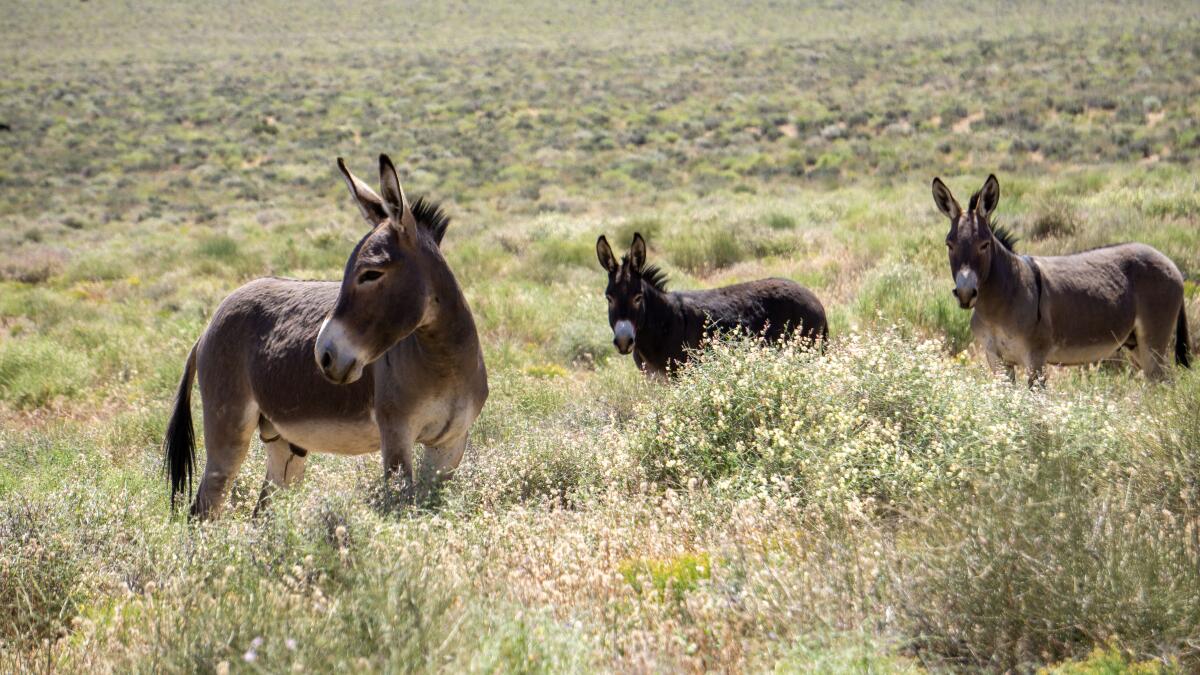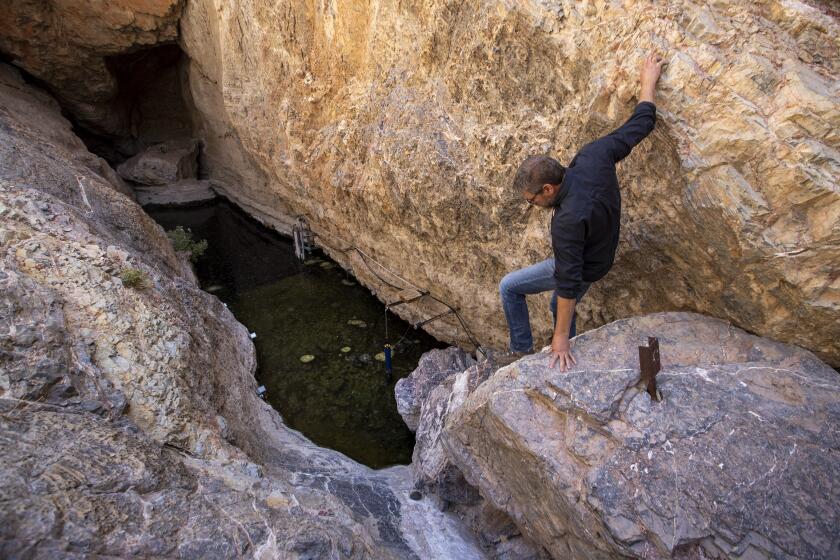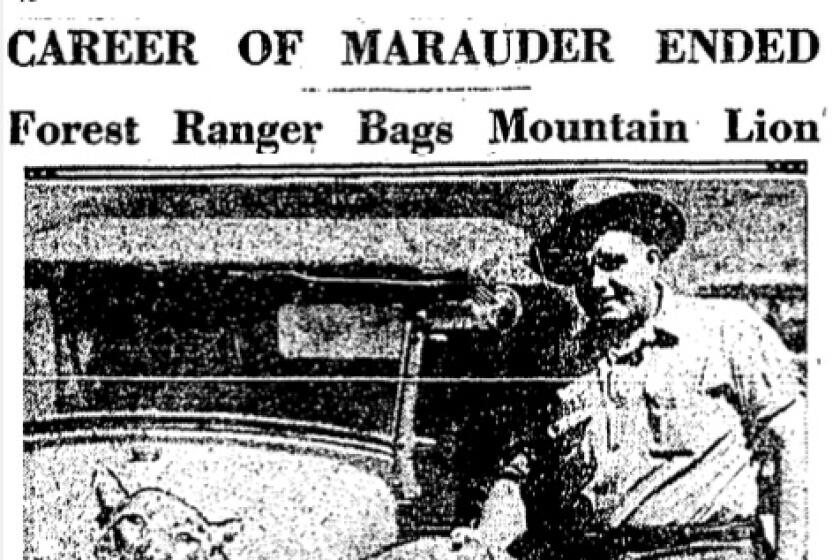Mountain lions are eating California wild donkeys. Why scientists say this is a good thing

- Share via
An apex predator has been quietly hunting interlopers in Death Valley, and for the first time, the deadly encounter has been captured on camera.
A mountain lion can be seen via nighttime images pouncing onto the back of an in-stride wild donkey.
The cougar easily wins the fight: A photograph taken seven minutes later shows it standing over the dead donkey, eyes glimmering as it stares into a wildlife camera.
“It’s extremely rare to get a predation on camera,” said Erick Lundgren, the biologist who captured the images. “I guess that just goes to show that [this] predation is really not [that] rare in Death Valley.”
The newly documented cougar-donkey dynamic has been the focus of little research, but it might illustrate a developing relationship between the two animals that could benefit the ecosystem, according to a recent study.
The feral donkeys, also known as burros, have long been considered invasive and major disruptors of native species and habitats in Death Valley, pillaging wetlands and destroying vegetation other animals rely on. But Lundgren is hoping this study could shift how conservationists and researchers view the donkeys.
The pool in Devils Hole, home to the endangered pupfish, saw waves erupt up to 4 feet high after a 7.6-magnitude earthquake hit near Mexico on Monday.
“I was interested in the wild donkeys, not just as a pest ... but as wildlife,” said Lundgren, the lead researcher of the report published in the Journal of Animal Ecology. “Which is, I think, how you should study them if you want to understand them.”
Not only did the study find the donkeys were the “primary recorded prey” of mountain lions in certain areas of the national park but also that the presence of the big cats changed how and when the donkeys fed, roamed and congregated, and their interaction formed an “emerging ecological network.”
The increased predation “was associated with altered donkey activity patterns and rates, and with reduced herbivory and disturbance-related effects on desert wetlands,” the study found. This limited damage from the donkeys in these areas.
“There’s a prevailing narrative that wild horses and wild burros are problems ... at some kind of biological level,” Lundgren said. “And I think that’s really non-scientific.”
However, in areas where the mountain lions were not as active, the study found donkeys continued to wreak havoc, the study found.

Although the wild donkeys are not native to North America — they descended from the domesticated African wild ass, which was brought west by pioneers during the Gold Rush — Lundgren notes the region was home to different horse-like species before the last Ice Age that lived alongside prehistoric mountain lions more than 10,000 years ago.
“Mountain lions co-occurred with equids [horse-related species], just like wild donkeys, for several million years,” he said. “So it’s kind of neat that they’re together again and that these new relationships are unfolding, which in many ways mimic old relationships that were around for millions of years.”
As the sun set on a landscape of scruffy mountains and sweeping plains, 20 wild burros watched Mark Meyers with ears erect.
For Mairin Balisi, a paleontologist and co-author of the study, the images of the mountain lion kill were the “return of an extinct interaction.”
“Fossil ecosystems are useful for providing baselines of conservation,” said Balisi, a curator at the Raymond M. Alf Museum of Paleontology in Claremont.
She said this evolving relationship in Death Valley has the potential to be a natural experiment in how the two species can benefit each other and the surrounding habitat. She likens the interaction to the successful reintroduction of the gray wolf in Yellowstone National Park, which had a positive effect on the food chain.
But currently, Death Valley officials remain committed to their zero burro goal in the park, given how a consensus of prior research shows the animals “denude vegetation at springs (sometimes completely), foul water with their excrement and prevent native wildlife, such as native bighorn sheep, from using springs,” Death Valley spokesperson Abby Wines said.
“Mountain lion predation is not sufficient to control the burro population in the park,” Wines said.
There are an estimated 4,000 feral burros on parkland today, a drastic increase from about 400 in 2005, she said. National park leaders have worked in recent years to humanely remove the burros from the park.
The state was essentially at war with cougars until the 1960s, when the bounties ended. As the big cats’ numbers declined, they came to enjoy more and more protections.
Kate Schoenecker, a research wildlife biologist for the U.S. Geological Survey at Fort Collins Science Center who studies wild burros, said it’s unlikely Death Valley will be able to eliminate the animals, given their protected status on nearby Bureau of Land Management and U.S. Forest Service land.
She didn’t question the park’s efforts to remove the donkeys through trapping efforts, but said she was excited the new study gave a more in-depth look at the understudied burros. Specifically, she pointed out how the research documented the donkeys’ “predator-risk avoidance behavior,” which can positively affect ecosystems.
“This is really cool because it’s never been studied for burros,” said Schoenecker, who noted the difficulty in drawing too many conclusions from the recent study given its small sample size and limited data.
“I think there’s a lot we still don’t know,” Schoenecker said. “We’re just still learning about basic demographic rates of burros.”
More than 100 of the roaming animals will be captured and sent to an adoption facility. Residents have mixed feelings.
Lundgren and Balisi agree there should be more research on the wild donkeys and their broader effects on the ecosystem.
“Ecologically important predator-prey interactions can emerge rapidly in novel ecosystems,” Lundgren said, noting he is concerned that total removal of the burros could have unintended consequences for the larger food chain and how continued threats to mountain lions could stunt this potentially beneficial relationship.
More to Read
Sign up for Essential California
The most important California stories and recommendations in your inbox every morning.
You may occasionally receive promotional content from the Los Angeles Times.













